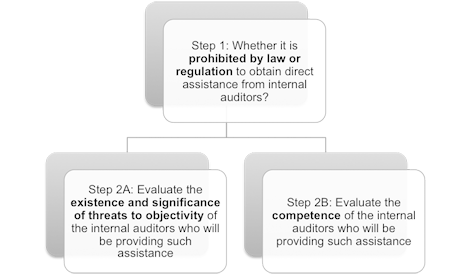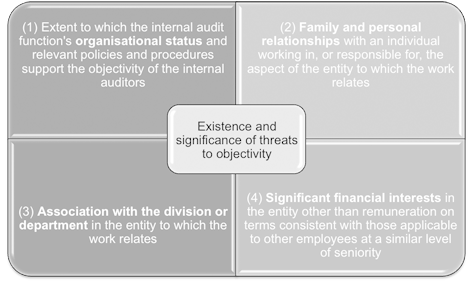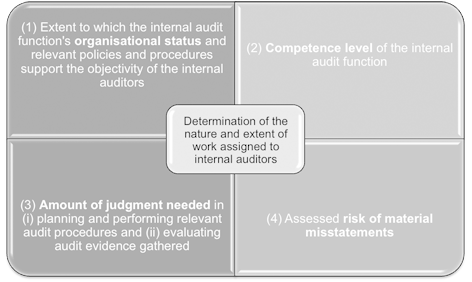Using the work of internal auditors
Can internal auditors be used to provide direct assistance to the external auditor for purposes of audit?
Relevant to ACCA Qualification exams AA and AAA
International Standard on Auditing (ISA) 610, Using the Work of Internal Auditors was revised and published in 2013. This standard focuses on whether the external auditor can use the work of the internal audit function for purposes of audit, and the revised version of the standard, clarified whether the internal auditors could be used to provide direct assistance to the external auditor.
Candidates taking AA and AAA should familiarise themselves with this aspect of the standard as they are expected to be able to discuss the extent to which external auditors are able to rely on the work of internal auditors (section D6 of the AA Study Guide) and to assess the appropriateness and sufficiency of the work of internal auditors as well as the extent to which reliance can be placed on it (section D4) of the AAA Study Guide).
External and internal auditors
Much of the work performed by a company’s internal audit function can overlap with the work conducted by the external auditor, specifically in areas dealing with the assessment of control processes. It is likely that in carrying out detailed work evaluating and reviewing the company’s internal control framework internal audit perform procedures on financial controls relevant to the external audit. As such, the external auditor, rather than duplicating these procedures, may be able to place reliance on the work carried out by the internal auditor.
This article focuses on the provision of direct assistance by the internal auditors, which historically has been a very controversial issue. Internal auditors are the employees of the entity, which could result in threats to independence (either in fact or perceived) if direct assistance is provided by the internal auditors. On the other hand, the following benefits relating to provision of direct assistance by the internal auditors cannot be ignored:
- There will be a strengthened relationship between the external and internal auditors through a more effective dialogue
- With the knowledge of the internal auditors, the external auditor can gain additional insights into the entity
- The external auditor can use internal auditors who may have relevant expertise in particular areas, and
- The external audit team can focus on the more significant audit issues.
Where such use is not prohibited by law or regulation, the ISA provides a robust framework to ensure that direct assistance is obtained only in appropriate circumstances, that the external auditor considers the relevant limitations and safeguards, and that the auditor’s responsibilities are clearly set out.
Guidance on determining if it is appropriate for internal auditors to provide direct assistance
When can internal auditors be used to provide direct assistance?
The external auditor, in the course of discharging their responsibilities must decide if it is appropriate in the circumstances to use internal audit to provide direct assistance. The ISA identifies a number of steps that the external auditor should work through when determining to what extent, if any, direct assistance can be provided.
Click to enlarge image
Step 1: Prohibition by law or regulation
The external auditor may be prohibited by law or regulation from obtaining direct assistance from internal auditors; therefore, the first task is to understand the law or regulation of the jurisdiction in which the auditor is operating. In the United Kingdom for example, the Financial Reporting Council (FRC) prohibits external auditors from using internal auditors as ‘direct assistance’ members of the audit team in order to enhance the principle of auditor independence. Consequently the guidelines in relation to direct assistance are irrelevant to audits conducted in accordance with ISAs (UK).
Step 2A: Evaluation of the existence and significance of threats to objectivity of the internal auditors
This is considered as an important element in the external auditor’s judgment as to whether internal auditors can provide direct assistance. Objectivity is regarded as the ability to perform the tasks without allowing bias, conflict of interest or undue influence of others to override professional judgment. The following factors are relevant to the external auditor’s evaluation of objectivity:
Click to enlarge image
It should be noted that the main purpose here is to evaluate threats to objectivity. Take the first factor as an example – if evidence shows that the internal audit function’s organisational status supports the objectivity of the internal auditors, the external auditor will feel more comfortable using direct assistance from the internal auditors. The following situations are likely to support the objectivity of the internal auditors:
- The internal audit function reports to those charged with governance (eg the audit committee) rather than solely to management (eg the chief finance officer)
- The internal audit function does not have managerial or operational duties that are outside of the internal audit function
- The internal auditors are members of relevant professional bodies obligating their compliance with relevant professional standards relating to objectivity.
Step 2B: Evaluation of the level of competence of the internal auditors
Competence of the internal audit function is likely to be deemed satisfactory where it can be evidenced that the function as a whole operates at the level required to (i) enable assigned tasks to be performed diligently and (ii) in accordance with applicable professional standards. To make such evaluation, the external auditor can take into consideration the following factors:
- Whether there are established policies for hiring, training and assigning internal auditors to internal audit engagements
- Whether the internal auditors have adequate technical training and proficiency in auditing (eg with relevant professional designation and experience)
- Whether the internal auditors possess the required knowledge relating to the entity’s financial reporting and the applicable financial reporting framework
- Whether the internal audit function possesses the necessary skills (for example, industry-specific knowledge) to perform work related to the entity’s financial statements.
Points to note in the evaluation
The above evaluation regarding the internal auditors’ objectivity and competence should not be new to candidates as it forms the basis for any assessment by the external auditor when determining if reliance can be placed on the work of internal auditors. The external auditor should bear in mind that the assessment of competence and objectivity are of equal importance, and should be assessed individually and in aggregate. For example if the internal auditors are deemed appropriately competent but the external auditor identifies significant threats to objectivity it is unlikely that the external auditor will be able to use the internal auditors to provide direct assistance and vice versa.
What can be assigned to internal auditors providing direct assistance?
Following the above detailed evaluation, if the external auditor determines that internal auditors, can be used to provide direct assistance for purposes of the audit, the next decision to be made by the external auditor is to determine the nature and extent of work that can be assigned to internal auditors.
This is a matter that requires the auditor to exercise professional judgment, due to the fact that extensive use of direct assistance could affect perceptions of the independence of external auditors. ISA 610 (Revised 2013) limits the circumstances in which direct assistance can be provided. The external auditor is advised to consider the following factors in such determination:
Click to enlarge image
The external auditor should have performed the assessment of the first two factors when determining whether the internal auditors can provide direct assistance in the first instance. The less persuasive the evidence regarding the internal auditors’ objectivity and competency, the more restrictive the nature and extent of work that can be assigned.
As a starting point the external auditor should consider the amount of judgment needed in (i) planning and performing relevant audit procedures and (ii) evaluating audit evidence gathered. The greater the level of judgment required, the narrower the scope of work that can be assigned to internal auditors. The following activities are deemed to involve significant judgment and therefore are not expected to be assigned to internal auditors providing direct assistance:
- Assessing risks of material misstatements
- Evaluating the sufficiency of tests performed
- Evaluating significant accounting estimates, and
- Evaluating the adequacy of disclosures in the financial statements and other matters affecting the auditor’s report.
For any particular account balance, class of transaction or disclosure, the external auditor has to take into consideration the assessed risk of material misstatement when determining the nature and extent of work that they propose to assign to internal auditors. The higher the assessed risk, the more restricted the nature and extent of work that should be assigned to internal auditors. If the risk of material misstatement is considered to be anything other than low, the more judgment that has to be involved and the more persuasive the audit evidence required. Therefore, in these circumstances, in order to reduce audit risk to an acceptably low level it is expected that the external auditor has to perform more procedures directly and place less reliance on assistance provided by internal auditors when collecting sufficient appropriate evidence. The ISA provides some specific examples of areas where reliance should be restricted.
ISA 610 (Revised 2013) states that internal auditors cannot carry out procedures when providing direct assistance that:
- Involve making significant judgment in the audit
- Relate to higher assessed risks of material misstatements where the judgment required in performing the relevant audit procedures or evaluating the audit evidence gathering is more than limited
- Relate to decisions the external auditor makes in accordance with ISA 610 (Revised 2013) regarding the internal audit function and the use of its work or direct assistance
- Relate to work with which the internal auditors have been involved and which has already been or will be reported to management (or those charged with governance) by the internal audit function. This restriction intends to minimise self-review threats.
ISA 610 (Revised 2013) also states that the following should not be assigned to or involve internal auditors providing direct assistance:
(i) discussion of fraud risks
(ii) determination of unannounced (or unpredictable) audit procedures as addressed in ISA 240, The Auditor’s Responsibilities Relating to Fraud in an Audit of Financial Statements, and
(iii) maintaining control over external confirmation requests and evaluation of results of external confirmation procedures.
Responsibilities of the external auditor using internal auditors to provide direct assistance
The external auditor should note the following responsibilities at different stages of the audit when using internal auditors to provide direct assistance:
(1) After determining the use of internal auditors to provide direct assistance
The external auditor has to:
- Communicate the nature and extent of the planned use of internal auditors with those charged with governance (in accordance with ISA 260, Communication with Those Charged with Governance) so as to reach a mutual understanding that such use is not excessive in the circumstances of the engagement. This communication not only dispels any perception that the external auditor’s independence might be compromised by the use of direct assistance but also facilitates appropriate dialogue with those charged with governance.
- Evaluate whether the external auditor is still sufficiently involved in the audit.
(2) Prior to the use of internal auditors to provide direct assistance
The external auditor has to obtain written agreement from two parties:
- From an authorised representative of the entity stating that: (i) the internal auditors will be allowed to follow the external auditor’s instructions, and (ii) the entity will not intervene in the work the internal auditor performs for the external auditors.
- From internal auditors stating that they will: (i) keep confidential specific matters as instructed by the external auditor and (ii) inform the external auditor of any threat to their objectivity.
(3) During the audit
The external auditor has to:
- Direct, supervise and review the work performed by internal auditors on the engagement, bearing in mind that the internal auditors are not independent of the entity. It is therefore expected that such supervision and review will be of a different nature and more extensive than if members of the audit engagement team perform the work.
- Remind the internal auditors to bring accounting and auditing issues identified during the audit to the attention of the external auditors.
- Check back to the underlying audit evidence for some of the work performed by the internal auditors.
- Make sure the internal auditors have obtained sufficient appropriate audit evidence to support the conclusions based on that work.
(4) Documenting the audit evidence
The documentation requirements evidencing the application of the important safeguards in ISA 610 (Revised 2013) have been expanded when the external auditor uses the internal auditors to provide direct assistance. The external auditor should document the following in the working papers:
- Evaluation of the existence and significance of the threats to the objectivity of the internal auditors and the level of competence of the internal auditors used to provide direct assistance
- The basis for the decision regarding the nature and extent of the work performed by the internal auditors
- Who reviewed the work performed and the date and extent of that review in accordance with ISA 230, Audit Documentation
- The written agreements obtained from an authorised representative of the entity and the internal auditors
- The working papers prepared by the internal auditors providing direct assistance on the audit engagement.
Conclusion
The external auditor has to exercise professional judgment when determining whether the internal auditors, subject to law and regulation, can be used to provide direct assistance in the financial statement audit of an entity. Candidates are expected to understand (i) how the external auditor makes such evaluations and (ii) for which processes or tasks the internal auditors can provide direct assistance to the external auditor. The most important principle is, in any circumstances, the external auditor should be sufficiently involved in the audit as the external auditor has the sole responsibility for the audit opinion expressed.
Reference
ISA 610 (Revised 2013), Using the Work of Internal Auditors, together with its Basis for Conclusions




